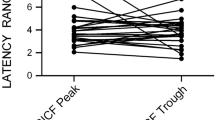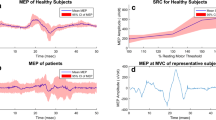Abstract
The aim of this study was to examine whether single-pulse transcranial magnetic stimulation (spTMS) affects the pattern of corticospinal activity once voluntary drive has been restored after spTMS-induced EMG silence. We used fractal dimension (FD) to explore the ‘complexity’ of the electromyography (EMG) signal, and median frequency of the spectra (MDF) to examine changes in EMG spectral characteristics. FD and MDF of the raw EMG epochs immediately before were compared with those obtained from epochs after the EMG silence. Changes in FD and MDF after spTMS were examined with three levels of muscle contraction corresponding to weak (20–40 %), moderate (40–60 %) and strong (60–80 % of maximal voluntary contraction) and three intensities of stimulation set at 10, 20 and 30 % above the resting motor threshold. FD was calculated using the Higuchi fractal dimension algorithm. Finally, to discern the origin of FD changes between the CNS and muscle, we compared the effects of spTMS with the effects of peripheral nerve stimulation (PNS) on FD and MDF. The results show that spTMS induced significant decrease in both FD and MDF of EMG signal after stimulation. PNS did not have any significant effects on FD nor MDF. Changes in TMS intensity did not have any significant effect on FD or MDF after stimulation nor had the strength of muscle contraction. However, increase in contraction strength decreased FD before stimulation but only between weak and moderate contraction. The results suggest that the effects of spTMS on corticospinal activity, underlying voluntary motor output, outlast the TMS stimulus. It appears that the complexity of the EMG signal is reduced after spTMS, suggesting that TMS alters the dynamics of the ongoing corticospinal activity most likely temporarily synchronizing the neural network activity. Further studies are needed to confirm whether observed changes after TMS occur at the cortical level.


Similar content being viewed by others
References
Accardo A, Affinito M, Carrozzi M, Bouquet F (1997) Use of the fractal dimension for the analysis of electroencephalographic time series. Biol Cybern 77:339–350
Anmuth CJ, Goldberg G, Mayer NH (1994) Fractal dimension of electromyographic signals recorded with surface electrodes during isometric contractions is linearly correlated with muscle activation. Muscle Nerve 17:953–954
Arjunan SP, Kumar DK (2007a) Fractal based modelling and analysis of electromyography (EMG) to identify subtle actions. Conf Proc IEEE Eng Med Biol Soc 2007:1961–1964
Arjunan SP, Kumar DK (2007b) Fractal theory based non-linear analysis of sEMG. 2007 International conference on intelligent sensors, sensor networks and information, ISSNIP 2007, pp 545–548
Arjunan SP, Kumar DK (2010) Decoding subtle forearm flexions using fractal features of surface electromyogram from single and multiple sensors. J Neuroeng Rehabil 7:53
Arjunan SP, Kumar DK, Naik GR (2010) Fractal feature of sEMG from Flexor digitorum superficialis muscle correlated with levels of contraction during low-level finger flexions. Conf Proc IEEE Eng Med Biol Soc 2010:4614–4617
Arle JE, Simon RH (1990) An application of fractal dimension to the detection of transients in the electroencephalogram. Electroencephalogr Clin Neurophysiol 75:296–305
Bilodeau M, Schindler-Ivens S, Williams DM, Chandran R, Sharma SS (2003) EMG frequency content changes with increasing force and during fatigue in the quadriceps femoris muscle of men and women. J Electromyogr Kinesiol 13:83–92
Bril V, Fuglsang-Frederiksen A (1984) Number of potential reversals (turns) and amplitude of the pattern of electrical activity of the abductor pollicis brevis muscle in patients with neurogenic diseases. Acta Neurol Scand 70:169–175
Chen B, Wang N (2000) Determining EMG embedding and fractal dimensions and its application. 22nd annual EMBS international conference. In: Proceedings of the 22nd annual EMBS international conference, pp 1341–1344
Christensen H, Lo MM, Dahl K, Fuglsang-Frederiksen A (1984) Processing of electrical activity in human muscle during a gradual increase in force. Electroencephalogr Clin Neurophysiol 58:230–239
Day BL, Dressler D, de Maertens NA, Marsden CD, Nakashima K, Rothwell JC, Thompson PD (1989) Electric and magnetic stimulation of human motor cortex: surface EMG and single motor unit responses. J Physiol 412:449–473
De Luca CJ (1984) Myoelectrical manifestations of localized muscular fatigue in humans. Crit Rev Biomed Eng 11:251–279
Devanne H, Lavoie BA, Capaday C (1997) Input-output properties and gain changes in the human corticospinal pathway. Exp Brain Res 114:329–338
Di Lazzaro V, Oliviero A, Profice P, Insola A, Mazzone P, Tonali P, Rothwell JC (1999a) Direct recordings of descending volleys after transcranial magnetic and electric motor cortex stimulation in conscious humans. Electroencephalogr Clin Neurophysiol Suppl 51:120–126
Di Lazzaro V, Oliviero A, Profice P, Insola A, Mazzone P, Tonali P, Rothwell JC (1999b) Effects of voluntary contraction on descending volleys evoked by transcranial electrical stimulation over the motor cortex hand area in conscious humans. Exp Brain Res 124:525–528
Duchene J, Goubel F (1993) Surface electromyogram during voluntary contraction: processing tools and relation to physiological events. Crit Rev Biomed Eng 21:313–397
Eke A, Herman P, Kocsis L, Kozak LR (2002) Fractal characterization of complexity in temporal physiological signals. Physiol Meas 23:R1–R38
Esteller R, Vachtsevanis G, Echauz J, Litt B (2001) A comparison of waveform fractal dimension algorithms. IEEE Trans Circ Syst 48:177–183
Farina D, Fattorini L, Felici F, Filligoi G (2002) Nonlinear surface EMG analysis to detect changes of motor unit conduction velocity and synchronization. J Appl Physiol 93:1753–1763
Fuglsang-Frederiksen A (1981) Electrical activity and force during voluntary contraction of normal and diseased muscle. Acta Neurol Scand Suppl 83:1–60
Fuhr P, Agostino R, Hallett M (1991) Spinal motor neuron excitability during the silent period after cortical stimulation. Electroencephalogr Clin Neurophysiol 81:257–262
Gitter JA, Czerniecki MJ (1995) Fractal analysis of the electromyographic interference pattern. J Neurosci Methods 58:103–108
Glenny RW, Robertson HT, Yamashiro S, Bassingthwaighte JB (1991) Applications of fractal analysis to physiology. J appl physiol (Bethesda, Md: 1985) 70:2351–2367
Goldberger AL, West BJ (1987) Fractals in physiology and medicine. Yale J Biol Med 60:421–435
Goldberger AL, Amaral LA, Glass L, Hausdorff JM, Ivanov PC, Mark RG, Mietus JE, Moody GB, Peng CK, Stanley HE (2000) Physiobank, physiotoolkit, and physionet: components of a new research resource for complex physiologic signals. Circulation 101:E215–E220
Gupta V, Suryanarayanan S, Reddy NP (1997) Fractal analysis of surface EMG signals from the biceps. Int J Med Inform 45:185–192
Hagg GM (1992) Interpretation of EMG spectral alterations and alteration indexes at sustained contraction. J Appl Physiol 73:1211–1217
Harris J, Clifford CWG, Miniussi C (2008) The functional effect of transcranial magnetic stimulation: signal suppression or neural noise generation? J cogn neurosci 20:734–740
Higouchi T (1988) Approach to an Irregular Time Series on the Basis of the Fractal Theory. Physica D 31:277–283
Kaneko K, Kawai S, Fuchigami Y, Morita H, Ofuji A (1996) The effect of current direction induced by transcranial magnetic stimulation on the corticospinal excitability in human brain. Electroencephalogr Clin Neurophysiol 101:478–482
Katz MJ (1988) Fractals and the analysis of waveforms. Comput Biol Med 18:145–156
Klonowski W (2002) Chaotic dynamics applied to signal complexity in phase space and in time domain. Chaos, Solitons Fractals 14:1379
Knaflitz M, Merletti R, De Luca CJ (1990) Inference of motor unit recruitment order in voluntary and electrically elicited contractions. J Appl Physiol 68:1657–1667
Lindstrom L, Hellsing G (1983) Masseter muscle fatigue in man objectively quantified by analysis of myoelectric signals. Arch Oral Biol 28:297–301
Linssen WH, Stegeman DF, Joosten EM, van’t Hof MA, Binkhorst RA, Notermans SL (1993) Variability and interrelationships of surface EMG parameters during local muscle fatigue. Muscle Nerve 16:849–856
Mesin L, Cescon C, Gazzoni M, Merletti R, Rainoldi A (2009) A bi-dimensional index for the selective assessment of myoelectric manifestations of peripheral and central muscle fatigue. J Electromyogr Kinesiol off j Int Soc Electrophysiol Kinesiol 19:851–863
Nakamura H, Kitagawa H, Kawaguchi Y, Tsuji H (1997) Intracortical facilitation and inhibition after transcranial magnetic stimulation in conscious humans. J Physiol 498(Pt 3):817–823
Nandedkar SD, Sanders DB, Stalberg EV (1986) Automatic analysis of the electromyographic interference pattern. Part II: findings in control subjects and in some neuromuscular diseases. Muscle Nerve 9:491–500
Oddsson LI, Giphart JE, Buijs RJ, Roy SH, Taylor HP, De Luca CJ (1997) Development of new protocols and analysis procedures for the assessment of LBP by surface EMG techniques. J Rehabil Res Dev 34:415–426
Oldfield RC (1971) The assessment and analysis of handedness: the Edinburgh inventory. Neuropsychologia 9:97–113
Paus T, Sipila PK, Strafella AP (2001) Synchronization of neuronal activity in the human primary motor cortex by transcranial magnetic stimulation: an EEG study. J Neurophysiol 86:1983–1990
Pickover M, Khorasani A (1986) Chaos and Fractals. Springer_Verlag, New York
Ravier P, Buttelli O, Jennane R, Couratier P (2005) An EMG fractal indicator having different sensitivities to changes in force and muscle fatigue during voluntary static muscle contractions. J Electromyogr Kinesiol 15:210–221
Rosler KM, Petrow E, Mathis J, Aranyi Z, Hess CW, Magistris MR (2002) Effect of discharge desynchronization on the size of motor evoked potentials: an analysis. Clin Neurophysiol 113:1680–1687
Rossini PM, Barker AT, Berardelli A, Caramia MD, Caruso G, Cracco RQ, Dimitrijevic MR, Hallett M, Katayama Y, Lucking CH (1994) Non-invasive electrical and magnetic stimulation of the brain, spinal cord and roots: basic principles and procedures for routine clinical application. Report of an IFCN committee. Electroencephalogr Clin Neurophysiol 91:79–92
Rothwell JC, Thompson PD, Day BL, Boyd S, Marsden CD (1991) Stimulation of the human motor cortex through the scalp. Exp Physiol 76:159–200
Silvanto J, Muggleton NG, Cowey A, Walsh V (2007) Neural adaptation reveals state-dependent effects of transcranial magnetic stimulation. Eur J Neurosci 25:1874–1881
Stam CJ (2005) Nonlinear dynamical analysis of EEG and MEG: review of an emerging field. Clin Neurophysiol 116:2266–2301
Taylor JL, Allen GM, Butler JE, Gandevia SC (1997) Effect of contraction strength on responses in biceps brachii and adductor pollicis to transcranial magnetic stimulation. Exp Brain Res 117:472–478
Wassermann EM, Epstein CM, Ziemann U, Walsh V, Paus T, Lisanby SH (2008) The Oxford handbook of transcranial stimulation. Oxford University Press, New York
Werhahn KJ, Fong JK, Meyer BU, Priori A, Rothwell JC, Day BL, Thompson PD (1994) The effect of magnetic coil orientation on the latency of surface EMG and single motor unit responses in the first dorsal interosseous muscle. Electroencephalogr Clin Neurophysiol 93:138–146
Xu Z, Xiao S (1997) Fractal dimensions of surface EMG and its determinants. 19th international conference—IEEE/EMB. In: Proceedings—19th international conference—IEEE/EMBS, pp 1570–1572
Acknowledgments
The research was partly supported by Ministry of Education and Science of Serbia projects 175090, 175012, III-41007 and III-43011 and FMHS UAE University Grant.
Author information
Authors and Affiliations
Corresponding author
Rights and permissions
About this article
Cite this article
Cukic, M., Oommen, J., Mutavdzic, D. et al. The effect of single-pulse transcranial magnetic stimulation and peripheral nerve stimulation on complexity of EMG signal: fractal analysis. Exp Brain Res 228, 97–104 (2013). https://doi.org/10.1007/s00221-013-3541-1
Received:
Accepted:
Published:
Issue Date:
DOI: https://doi.org/10.1007/s00221-013-3541-1




